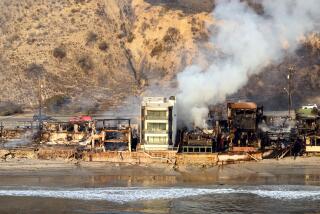L.A.’s epic task: Fixing buildings that earthquakes could flatten
- Share via
Certain types of old concrete buildings have long been considered to have the most potential for loss of life in a major quake.
Recent earthquakes have spotlighted the deadly potential of buildings held up by concrete. A 2011 quake in Christchurch, New Zealand, toppled two concrete office towers, killing 133 people. Many of the 6,000 people killed in a 1995 earthquake in Kobe, Japan, were in concrete buildings. In 1971, the Sylmar earthquake brought down several concrete structures, killing 52. Twenty-three years later, the Northridge earthquake wrecked more, including a Bullock’s department store and Kaiser medical office.
On Friday, the Los Angeles City Council voted to require property owners of vulnerable buildings to make retrofits.
Here’s how it came together:
See the most-read stories this hour >>
Q: How many potential dangerous concrete buildings are there in L.A.?
In 2013, a team of Times reporters mined thousands of city and county records to identify older concrete buildings. The Times found more than 1,000 buildings in Los Angeles and hundreds elsewhere in the county that appeared to be concrete.
Reporters walked through seven L.A. business districts to gauge the accuracy of the list. They pulled building permits and sent questionnaires to dozens of property owners, asking them to review the details. In these areas, The Times found 68 older concrete buildings, according to public records. Of those, just seven had been retrofitted, or strengthened to survive large earthquakes. The reporters’ work covered a fraction of the older concrete structures in the city.
The survey showed the difficulties of accurately identifying concrete buildings. Some city records didn’t specify the construction materials used. Some buildings that appeared to be made of concrete turned out to be steel framed, while others that appeared to be brick or steel were concrete.
Not all of these buildings would collapse in a big quake. More studies would be needed to determine which ones are most at risk.
Q: How would that process work?
To determine whether a building needs retrofitting, owners would have to spend as much as $100,000 on a structural study that ascertains what is inside the columns.
They would have to hire engineers who might install angled steel beams to provide more support, like an exoskeleton. Another solution could be the addition of sturdy interior concrete walls that stretch from the ground to the roof. The fixes could cost $1 million or more. Occupants probably would have to move out during the renovation, at an additional cost.
Q: How long have we known about the dangers of concrete buildings?
In 1971, the Sylmar quake shattered two concrete structures at the 46-year-old Veterans Administration Hospital in San Fernando. The three-story buildings pancaked when the concrete crumbled, leaving the red tile roof smashed on the ground. Many patients were crushed under the debris; 49 people died.
Seismic experts were more alarmed by Olive View Medical Center in Sylmar, which had opened just months before and was built using stricter codes. The five-story hospital lurched sideways when some of its first-floor columns broke. Three concrete stairwells toppled. A two-story psychiatric building collapsed. Three people died.
After Sylmar, L.A. officials beefed up seismic codes for new buildings, requiring more steel inside concrete columns to prevent chunks from breaking away. The extra steel acts like a cage, keeping the concrete in place, even if the column cracks.
But structures built before the mid-1970s remained at risk because many lack adequate steel rebar and can’t bend. Engineers call these buildings “non-ductile.”
When more concrete buildings fell in the 1994 Northridge earthquake, Los Angeles Councilman Hal Bernson and Karl Deppe, a top city building official, decided the time was right to push for tougher retrofitting laws.
But those efforts failed to gain traction at City Hall.
ALSO:
L.A. approves nation’s toughest earthquake safety rules
How L.A. conquered an earthquake danger zone: Brick buildings
Graphic: How concrete buildings fail in earthquakes
More to Read
Sign up for Essential California
The most important California stories and recommendations in your inbox every morning.
You may occasionally receive promotional content from the Los Angeles Times.













